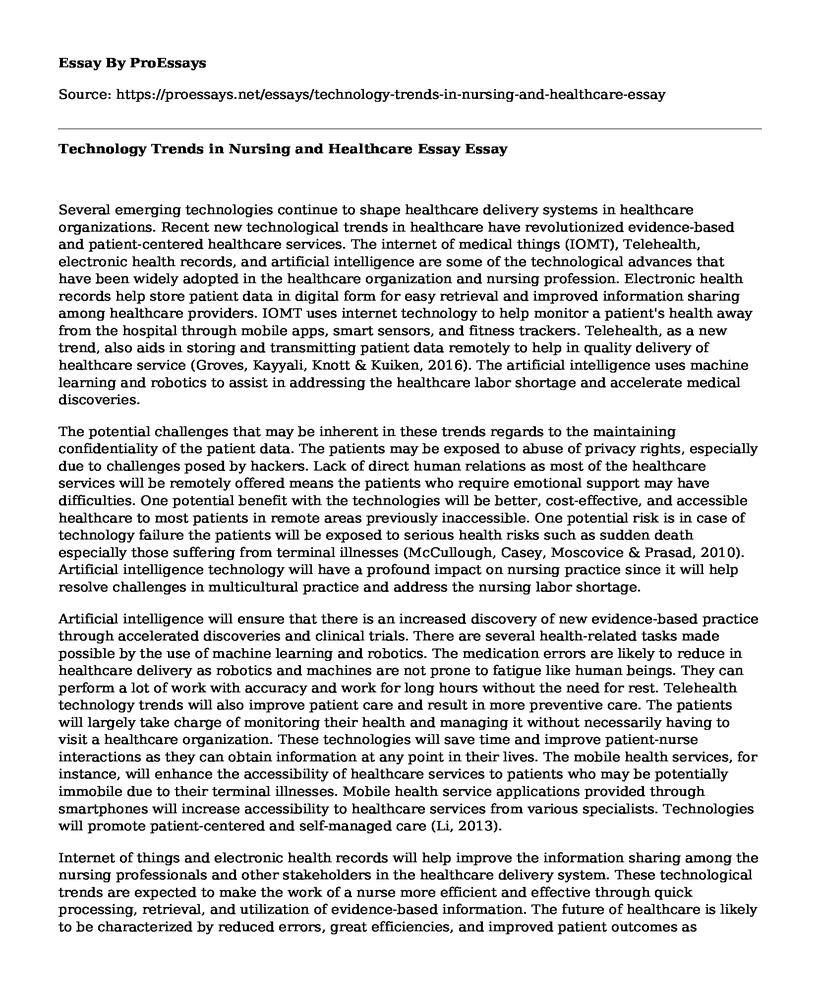Several emerging technologies continue to shape healthcare delivery systems in healthcare organizations. Recent new technological trends in healthcare have revolutionized evidence-based and patient-centered healthcare services. The internet of medical things (IOMT), Telehealth, electronic health records, and artificial intelligence are some of the technological advances that have been widely adopted in the healthcare organization and nursing profession. Electronic health records help store patient data in digital form for easy retrieval and improved information sharing among healthcare providers. IOMT uses internet technology to help monitor a patient's health away from the hospital through mobile apps, smart sensors, and fitness trackers. Telehealth, as a new trend, also aids in storing and transmitting patient data remotely to help in quality delivery of healthcare service (Groves, Kayyali, Knott & Kuiken, 2016). The artificial intelligence uses machine learning and robotics to assist in addressing the healthcare labor shortage and accelerate medical discoveries.
The potential challenges that may be inherent in these trends regards to the maintaining confidentiality of the patient data. The patients may be exposed to abuse of privacy rights, especially due to challenges posed by hackers. Lack of direct human relations as most of the healthcare services will be remotely offered means the patients who require emotional support may have difficulties. One potential benefit with the technologies will be better, cost-effective, and accessible healthcare to most patients in remote areas previously inaccessible. One potential risk is in case of technology failure the patients will be exposed to serious health risks such as sudden death especially those suffering from terminal illnesses (McCullough, Casey, Moscovice & Prasad, 2010). Artificial intelligence technology will have a profound impact on nursing practice since it will help resolve challenges in multicultural practice and address the nursing labor shortage.
Artificial intelligence will ensure that there is an increased discovery of new evidence-based practice through accelerated discoveries and clinical trials. There are several health-related tasks made possible by the use of machine learning and robotics. The medication errors are likely to reduce in healthcare delivery as robotics and machines are not prone to fatigue like human beings. They can perform a lot of work with accuracy and work for long hours without the need for rest. Telehealth technology trends will also improve patient care and result in more preventive care. The patients will largely take charge of monitoring their health and managing it without necessarily having to visit a healthcare organization. These technologies will save time and improve patient-nurse interactions as they can obtain information at any point in their lives. The mobile health services, for instance, will enhance the accessibility of healthcare services to patients who may be potentially immobile due to their terminal illnesses. Mobile health service applications provided through smartphones will increase accessibility to healthcare services from various specialists. Technologies will promote patient-centered and self-managed care (Li, 2013).
Internet of things and electronic health records will help improve the information sharing among the nursing professionals and other stakeholders in the healthcare delivery system. These technological trends are expected to make the work of a nurse more efficient and effective through quick processing, retrieval, and utilization of evidence-based information. The future of healthcare is likely to be characterized by reduced errors, great efficiencies, and improved patient outcomes as technologies continue to grow and make work easier (Li, 2013). The level of access to healthcare is likely to improve through the new technological trends and also improved efficiencies in data management.
References
Groves, P., Kayyali, B., Knott, D., & Kuiken, S. V. (2016). The'big data' revolution in healthcare: Accelerating value and innovation.
Li, K. F. (2013). Smart home technology for telemedicine and emergency management. Journal of Ambient Intelligence and Humanized Computing, 4(5), 535-546. Retrieved from: https://link.springer.com/article/10.1007/s12652-012-0129-8
McCullough, J. S., Casey, M., Moscovice, I., & Prasad, S. (2010). The effect of health information technology on quality in US hospitals. Health Affairs, 29(4), 647-654. Retrieved from: https://www.healthaffairs.org/doi/full/10.1377/hlthaff.2010.0155
Cite this page
Technology Trends in Nursing and Healthcare Essay. (2022, Mar 11). Retrieved from https://proessays.net/essays/technology-trends-in-nursing-and-healthcare-essay
If you are the original author of this essay and no longer wish to have it published on the ProEssays website, please click below to request its removal:
- Antibiotic Resistance and Impact on Human Health
- Paper on Nurse Manager in Critical Care: Passionate and Motivated Candidate
- Essay Sample on Microcontrollers: Specialized Computers for Specific Purposes
- Essay Sample on Forgotten: Examining Long-Term Memory Loss & Repressed Memories
- Essay Example on Biological Factors in Human Behavior: COVID-19 Impact
- Paper Example on COVID-19: Global Economic Crisis - Millions Infected, Businesses Counting Losses
- Free Essay Sample on Technology Into Our Daily Lives







